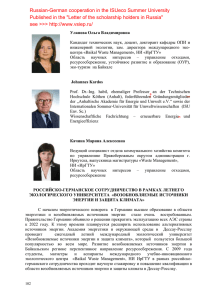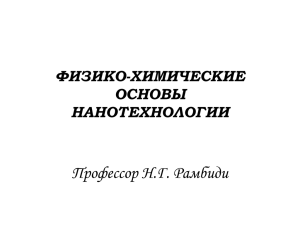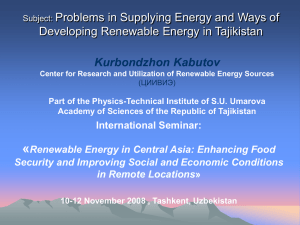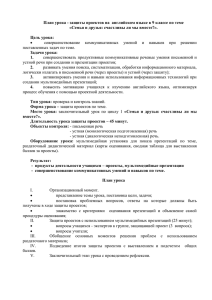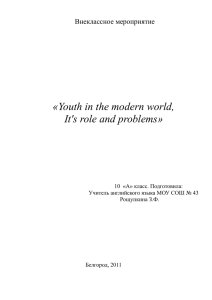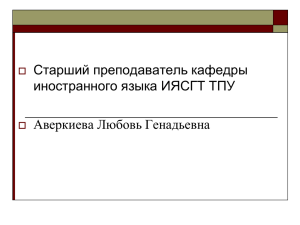ШАГ 1 - Консорциум ЕС
реклама
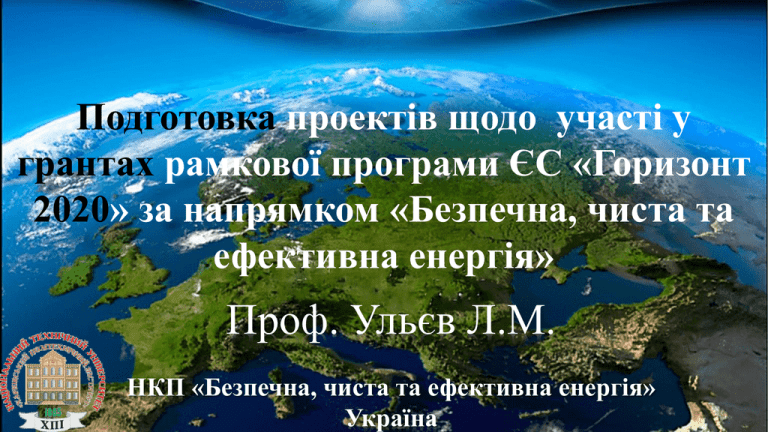
Подготовка проектів щодо участі у грантах рамкової програми ЄС «Горизонт 2020» за напрямком «Безпечна, чиста та ефективна енергія» Проф. Ульєв Л.М. НКП «Безпечна, чиста та ефективна енергія» Україна Что такое ГОРИЗОНТ 2020? Что такое ГОРИЗОНТ 2020? • Это инструмент финансирования Европейским Союзом Исследовательских и Инновационных (внедрение) проектов в период 2014-2020 годов Что такое ГОРИЗОНТ 2020? • Это инструмент финансирования Европейским Союзом Исследовательских и Инновационных (внедрение) проектов в период 2014-2020 годов • Бюджет в размере 70,2 млрд. Евро Что такое ГОРИЗОНТ 2020? • Это инструмент финансирования Европейским Союзом Исследовательских и Инновационных (внедрение) проектов в период 2014-2020 годов • Бюджет в размере 70,2 млрд. Евро • От исследований к внедрению - от фундаментальных исследований до рынка Что такое ГОРИЗОНТ 2020? • • • • Это инструмент финансирования Европейским Союзом Исследовательских и Инновационных (внедрение) проектов в период 2014-2020 годов Бюджет в размере 70,2 млрд. Евро От исследований к внедрению - от фундаментальных исследований до рынка Фокусировка на социальных проблемах общества ЕС (например, здравоохранение, чистая энергетика, продовольственная безопасность, транспортная интеграция) Что такое ГОРИЗОНТ 2020? • • • • • Это инструмент финансирования Европейским Союзом Исследовательских и Инновационных (внедрение) проектов в период 2014-2020 годов Бюджет в размере 70,2 млрд. Евро От исследований к внедрению - от фундаментальных исследований до рынка Фокусировка на социальных проблемах общества ЕС (например, здравоохранение, чистая энергетика, продовольственная безопасность, транспортная интеграция) Упрощенный доступ для всех участников Структура ГОРИЗОНТА 2020 Научные достижения Европейский исследовательский совет (ERC) Развитие и обновление технологий Marie Skłodowska-Curie Actions (MSCA) Исследовательские коммуникации Промышленное Лидерство Лидерство в высокоэффективных и промышленных технологиях – ICT, космос, KET Социальные вызовы Здоровье и благополучие Безопасность питания Транспорт Доступ к рисковому капиталу Развитие малого бизнеса Энергия Изменение климата Гражданское общество Безопасность Расширение взаимодействия между Наукой и Обществом Три приоритета Детальный обзор Стабильная продовольственная безопасность Персонализация здоровья и ухода Конкурентоспособная низко углеродная энергетика Развитие отраслей, связанных с морем Развитие мобильности Умные города и сообщества Водные инновации Новые идеи для Европы Противодействия бедствиям Цифровая безопасность Энергоэффективность Отходы Типы проектов SP: Совместный проект "Традиционные" многонациональные, мульти-партнерские совместные проекты 100% - исследования 70% - рынок, SME CSA: Координация и поддержка “Традиционные” многонациональные, мультипартнерские действия поддержки 100% или 70%. Этот тип проекта не подразумевает финансирование исследований. действий SME Инструмент cPPP: договорное Государственное/Частное партнерство ERANET Награда PCP: Предконтрактнае преобретение Проекты типа SME Instrument направлены на "все типы Предприятий среднего и малого бизнеса (ПСМ), которые имеют четкие намерения развиваться, расти и интернационализироваться". (3 Этапа) Транспортное средство рассматривает конкретный технологический план действий. Часть финансируется отраслью. ЕС финансирование элемент из Горизонта 2020. Выпуск научно-исследовательских Calls - тот же самый режим финансирование, как Горизонта 2020 Научно-исследовательские программы, которыми управляет сеть национальных инвесторов в определенной области в рамках финансирования ЕС от Горизонта 2020. Исследование Colls обращается к их собственным режимам финансирования Премии используются для “Официального признания уже достигнутых результатов (“recognition prizes”), или побуждения к созданию новых (“inducement prizes”)”. Премии выдаются на конкурсной основе. Неконкурентные действия Полезные Ссылки • CORDIS является основным общественным репозитарием Европейской комиссии и порталом, для распространения информации обо всех финансируемых ЕС научноисследовательских проектах и их результатах в самом широком смысле. • http://cordis.europa.eu/fp7/ict/programme/fet_en.html Взаимодействие между основными приоритетами Продовольс твенная проблема Проблема климата Энергетиче ская проблема Проблема транспорта Проблема здравоохра Проблема нения Проблема безопасности международных отношений Проект рабочих программ для 2015 • Calls предложений разделен на три направления: Энергоэффективность (16 тем) Конкурентоспособная низкоуглеродная энергетика (20 тем) Умные города и сообщества (2 темы) • Типы проектов, которые будут финансироваться: • Совместные проекты (со 100% возмещением) • Координация и поддержка действия • Несколько ERANET • Некоторые темы, финансируются с помощью государственных инвестиций • Также: финансируются благодаря энергоэффективным зданиям и стабильным предприятиям государственно-частного партнерства перерабатывающих отраслей промышленности Полезные ссылки • Европейская комиссия, Исследование DG & Инновация / энергетика вебсайт: http://ec.europa.eu/research/energy/index_en.cfm • План европейских стратегических энергетических технологий веб-сайт: http://ec.europa.eu/energy/technology/set_plan/set_plan_en.htm • Европейская комиссия, DG энергетика веб-сайт: http://ec.europa.eu/energy/index_en.htm • Fuel Cells and Hydrogen Joint Technology Initiative веб-сайт: http://www.fch-ju.eu/ • Знания и инновационное сообщество в инновационной энергетике вебсайт: http://www.kic-innoenergy.com/ • Знание климата и инновационное сообщество веб-сайт: http://www.climate-kic.org/ Как стать участником 7 шагов для получения финансирования Вашего проекта: ШАГ 1: Определитесь с конкурсом (условия, deadline) ШАГ 2: Получите документы и формы конкурса (Информационный пакет на портале участника) ШАГ 3: Организуйте консорциум (Партнерская служба на сайте CORDIS) ШАГ 4: Подготовьте Ваш проект и подайте его на рассмотрение в Европейскую Комиссию своевременно. (Система электронной подачи) ШАГ 5: Оценивание ШАГ 6: Подписание грантового соглашения ШАГ 7: Запустите проект и начните исследования Официальный сайт Horizon 2020 http://ec.europa.eu/horizon2020 Программы Horizon 2020 Безопасная, чистая и энергоэффективная энергетика Раздел: «Безопасная, чистая и энергоэффективная энергетика» http://ec.europa.eu/programmes/horizon2020/en/h2020-section/secure-clean-and-efficient-energy Отдел новостей статья Активные Colls Темы для Colls http://ec.europa.eu/research/participants/portal/desktop/en/opportunities/h2020/topics/2368-ee-06-2015.html Доступные темы Описание темы Условие и документы Сервис подачи заявки Национальный Контактный Пункт http://web.kpi.kharkov.ua/horizon2020/ru/ СТРУКТУРА ПРОЕКТНОЇ ПРОПОЗИЦІЇ Проектні пропозиції, що подаються на конкурси Програми «Горизонт 2020», складаються з двох частин: • Частина А – Адміністративні форми (містить загальну інформацію за проектом, інформацію про учасників та необхідне фінансування) • Частина В – Технічний додаток (містить опис проектної пропозиції). Адміністративні форми (Administrative Forms) Технічний додаток (Technical Annex) Усталеного зразка Форма 1 – Загальна інфор-мація (General information) (+анотація проекту) Титульна сторінка Зміст Форма 2 – Адміністративні дані установучасниць (Administrative data of participating organi sation) Розділ 1 Опис проекту (Excellence) Форма 3 – Бюджет проекту (Budget for the proposal) Розділ 3 Виконання (Implementation) Форма 4 – Етичні питання (Ethic issues table) Розділ 4 Учасники консорціуму (Members of the consortium) Форма 5 – Спеціальні питання (Call specific questions) Розділ 5 Етичні питання та безпека (Ethical issues and security) Розділ 2 Вплив проекту (Impact) проекту Заг. сума 100 K) Очікуваний розмір гранту/ € J) Макс. розмір гранту/ € (=H*I) (I) Ставка відшкодування витрат H) Загальна сума прийнятних витрат/€ (=A+B+C+D+E+F+G) G) Спеціальні витрати, які покривають прямі та непрямі витрати (F) Непрямі витрати/ € (= 0,25* (A+B-E)) E) Кошти на товари та послуги, залучені з інших джерел/ € (D) Прямі витрати, пов’язані із фінансуванням третіх сторін/ € (С) Прямі витрати на субпідряд/ € (В) Інші прямі витрати/ € (A) Прямі витрати на персонал/ € Назва країни Учасник ФОРМА ТИПОВОЇ ПРОЕКТНОЇ ПРОПОЗИЦІЇ Серед форм Частини А докладніше розглянуто Бюджет проекту. Форма 3 Бюджет проекту Проектні пропозиції подаються координатором виключно в режимі on-line через Систему електронного подання (Electronic Submission Service). Для ознайомлення аплікантів з структурою проектної пропозиції нижче подано Форму типової проектної пропозиції (Standart Proposal Template, адреса сайту – http://ec.europa.eu/research/participants/data/ref/h2020/call_ptef/pt/h2 020-call-pt-ria-ia_en.pdf ) Однак, остаточні форми (які можуть дещо відрізнятись від Типової форми) розміщені в електронній системі подання на «Порталі учасників» (Participant Portal, адреса сайту – http://ec.europa.eu/research/participants/portal/desktop/en/opportunitie s/h2020/topics/2700-mg-3.6a-2015.html#tab3 Call: H2020-EE-2015-1-PPP Research and Innovation actions Innovation actions COVER PAGE INNOVATIVE LOW ENERGY CONSUMPTION HOUSE BUILDING DESIGN METHODS WITH USE OF RENEWABLES List of participants Participant No * 1 Coordinator 2 3 4 5 6 7 8 Participant organisation name Acamp Architectes (ACARCH) NANOTEC EU sro (NANOTEC) Centre for Sustainable Development of Energy, Water and Environment Systems (SDEWES) University of Manchester (UNIMAN) Stockholm School of Economics Institute for Research (SIR) “Spivdruzhnist-T” LLC (SODRU) LLC “Ukrstroykomplekt” (USK) V.N. Karazin Kharkiv National University (KKNU) Country France Slovakia Croatia U.K. Sweden Ukraine Ukraine Ukraine Excellence 1.1 Objectives The specific strategic objectives of the InTheBIOS Innovation Action are: To develop the Innovative Technology of low energy consumptive ‘nearly zero-energy’ building with use of renewable materials and renewable energy. To develop the principles and the methodology of the Integrated Design of Low Energy Consumptive Renewable Based Building. 1.2 Relation to the work programme The Project Proposal relates to EE 2-2015: Building design for new highly energy performing buildings. Building energy consumption in EU countries increases comparatively with 1990 and now accounts about 41% of total energy consumption in the European Union . 1.3 Concept and approach The concept of Low Energy Consumptive Building incorporates and integrates a variety of strategies during design, construction and operation of building projects. The basic strategies related to energy saving building are as follows: use of ‘Green’ Building Materials with high thermal resistance that lets to save energy for space heating; Gender factor The female factor in Green Building now essentially increases. The excellent example is the activity of Tiffany S.Shroeder, Green Government Consultant and FGBC Certifying Agent, Florida, USA ([email protected]). 1.4 Ambition The ‘green’ renewable materials best state-of art for today is the use of straw bales with the earthen material inside and outside enveloping. The enveloping is made on site. 2. Impact 2.1 Expected impacts The main focus of the proposed project is to promote innovative Low Energy Consumption Building design with use of Innovative Renewable - based Building Materials and Energy Saving Technical Building System integrated into building system with renewable based energy supply. Technological Advances and Market Impacts. The proposed project will move the technological frontiers in the fields of: Building sector which needs on non – expensive, low energy consumptive environmental friendly and comfort buildings; Environmental Benefits. Common building materials industry hardly impacts on the environment. For example, five to ten tons of cement are used to build the average middle class house and for every ton of cement manufactured a ton of CO2 is released. Health Benefits. Health benefits firstly are connected with high value of thermal resistance of innovative building material. Social Impacts. One of social impact includes the creation of additional job opportunities. Barriers/obstacles Possible barriers/obstacles may be connected with developed renewable based composed building materials and further building construction jurisdiction. The basic information about such materials testing techniques, expected capacities and construction methods is relatively consistent for different national building codes. But 2.2 Measures to maximize impact. a) Dissemination and exploitation of results The Consortium as a whole and its individual participants are planning the following activities for dissemination and exploitation of the main results of the project. Throughout the project: Each member of the consortium will carry out dissemination activities using direct links with industrial partners and municipal authorities. Publications in international scientific and practical editions for the academic and industrial community. After the completion of the project SMEs participants (again both from Ukraine and EU) will exploit and implement the novel technology in their design and consultancy services. b) Communication activities Communication activities have to promote the project in several directions: scientific and engineering environment; architect project organizations including these what are dealing with development of building codes, amendments to these codes, building norms and rules; local authorities of different levels; related ministries, Governmental committees; non-governmental organizations including these what are of “green” profile; building companies as potential customers or investors; companies which manufacture the high effective energy saving equipment; and wide mass media. 3. 3.1 Implementation Work plan — Work packages, deliverables and milestones 1-4 Work packages and tasks and milestones M and dileverables D Determination of technological properties of "green" renewable building materials Study of the raw materials quality Determination of building materials chemical and biological resistance Determination of mechanical properties and characteristics Determination of physical properties 1-5 Determination of thermal properties 1-6 Study of sound 1-7 Estimation of the penetrating radiation intensity reduction Fire tests 1 1-1 1-2 1-3 1-8 2 2-1 2-2 2-3 New building materials and technology design of construction The technology of renewable based composed building materials manufacturing Thermal design taking into account the climatic zones and the creation of comfortable conditions indoors. To develop the integration procedure of renewable based Technical Building System Months 1 M 2 3 4 1.Year 5 6 7 8 D D 2. Year 9 10 11 12 1 2 3 4 5 6 7 8 9 10 11 12 M D, M D, M D, M D, M D, M D, M D D D Table 3.1a: Work package description For each work package: USK KKNU 9 SODRU 15 SIR Person/months per participant: UNIMAN ACARCH Short name of participant SDEWES Participant number WP1 Month 1 Start Date or Starting Event Determination of technological properties of "green" renewable building materials 1 2 3 4 5 6 7 8 NANOTEC Work package Work package title 20 2 5 22 14 68 Objectives Determination of biological stability "green" building materials Determination of porosity and density Description of work (where appropriate, broken down into tasks), lead partner and role of participants The basic duty characteristics of buildings are the life cycle duration, safety and economy that are defined with nature, physical, thermal and mechanical characteristics of building materials as parts of building construction. KKNU is the leader in WP1. Task 1. Study of the raw materials quality (KKNU, SDEWES, UNIMAN) The feed stock of biomass raw material study. Deliverables (brief description and month of delivery) D1-1. Report 1 – Month 8: The methods for the determination of technological properties of "green" composite building; Chemical and biological resistance of building materials had been determinate; Mechanical properties and characteristics of building materials had been determinate D1-2. Report 2 – Month 12: Table 3.1b: List of work packages Work packag e No WP1 WP2 WP3 WP4 WP5 WP6 WP7 WP8 Work Package Title Determination of technological properties of "green" renewable building materials New building materials and technology design of construction The use of renewable based building materials for thermal insulation of existing buildings Low Energy Consumption Pilot House with use of developed renewable based building materials Energy planning of settlements Lead Participant No Lead Participant Short Name PersonMonths Start Month End month 8 KKNU 68 1 12 2 NANOTEC 65 1 24 6 SODRU 51 12 24 7 USK 54 25 48 4 UNIMAN 14 25 48 Marketing investigation 4 Project management 1 Dissemination and spread of 2 InTheBIOS SIR ACARCH SDEWES 38 63 27 1 1 13 48 48 48 Total months 1525 Graphical presentation of work packages InTheBIOS Pert Diagram WP1 WP2 WP3 New building materials and technology design of construction The use of renewable based building materials for thermal insulation of existing buildings WP4 WP5 Energy planning of settlements OUTCAMES Software Materials Insulation Documentation Building WP8 Dissemination WP6 Low Energy Consumption Pilot House with use of developed renewable based building materials Marketing investigation WP7 Project management Determination of technological properties of "green" renewable building materials Table 3.2a: List of milestones Milestone number 1 2 3 4 5 6 7 8 9 10 11 12 13 14 15 16 17 18 19 Milestone name Related work package(s) Estimated date Means of verification Kick off Meeting General meeting Progress and Management reporting consolidated and approved by the Steering Committee Project web-site Methods for determination of technological properties Full Network meeting Prototype construction materials Report of comparison Technical documentation Building Methodology of energy saving uptake Energy plans on partner countries Report on analysis of resources Report on market analysis Report on market potential Report to the Commission Progress conference Progress conference Final InTheBIOS conference WP7 WP7 WP7 Month 1 Month 1, 12, 24, 36 Month 1, 6, 12, 18, 24, 30, 36, 42, 48 Minute of meeting Meeting report Reports delivered WP7 WP1 Month 1 Month 1 Web-site Meeting have taken place WP1 WP2 Month 12 Month 12 Meeting report Prototypes WP3 WP4 WP4 WP5 Month 36 Month 36 Month 48 Month 36 Meeting report Meeting report Prototypes Meeting report WP5 Month 48 Meeting report WP6 WP6 WP6 WP7 WP8 WP8 WP8 Month 6 Month 12 Month 18 Month 12, 24, 48 Month 12 Month 36 Month 48 Meeting report Meeting report Meeting report Project report Conference Conference Conference 3.2 Management structure and procedures Steering Committee Project Office InTheBIOS Network of all partners WP1 WP2 WP3 WP4 WP5 WP6 Task Leaders Task Leaders Task Leaders Task Leaders Task Leaders Task Leaders Within the management structure two different decision levels are established: Strategic level, represented by the Steering Committee (SC) to manage the overall strategy and financial, scientific and technical progress of the project Operational level, represented by the Work Package leaders to implement the scientific & technical activities necessary to achieve the objectives of the project. The management structure will consist of the following bodies: Steering Committee, consisting of leaders of individual Work Packages, Activity coordinators, and chaired by the Project coordinator Project Office for daily management and supporting the Steering Committee Work package leaders, coordinating individual work packages InTheBIOS Network of all partners Steering Committee The Steering Committee (SC) can be considered as the overall scientific and financial management and coordination board of the project. All important decisions regarding scientific and technical activities, finances, priorities, remediation actions, etc. will be taken within the SC. The tasks, responsibilities and competences of the SC can be summarized as follows: Decision making body for the project regarding scientific and technical activities and hereto related financial and person power planning, including decision making about priorities Monitoring of progress of all scientific and technical activities within the Work packages, including taking of remediation actions in case of delay in progress The Steering Committee (SC), chaired by the Project Coordinator, will consist of the leaders of the work packages 1 – 6. The SC will meet at least 2 times a year and at the end of the project. The SC meetings will last half a day each and for practical reasons will precede the InTheBIOS Network meetings of all partners (WP7). Table 3.2b Critical risk for implementation Description of risk Doubtful results obtained after raw material quality study Partner cannot to present the necessary data or information in time Work package(s) involved WP-1 Partner cannot to carry out his task in time WP-1 – WP-6 Long term natural disasters such as earthquake, hurricanes, flood, downpour do not let to collect components of building materials and to carry out building works at selected locations. Existing building related legislation of country-partner or national building codes prohibit the building of houses constructed with use of developed materials WP-1,WP-2,WP-4 Refuse of investor to purchase or delivery the piece of land for Pilot House building WP-4 WP-1 – WP-6 WP-4, WP-5 Proposed risk-mitigation measures To extend the nomenclature of raw materials or to diversify raw materials If it is not crucial for project performance the necessary data or information are generated and presented by another partner with appropriate budget correction Similar to above risk mitigation measure or change of appropriate partner will done through addressing of Coordinator and Steering Committee to Euro Commission According to developed appropriate databases the another locations for building materials collection and building works will be selected The use of legislative base related to ‘green’ legislation. The addressing of Coordinator and Steering Committee to Euro Commission to initiate the improvement of appropriate legislation. The negotiations with another investor selected from developed database. 3.3 Consortium as a whole • Achievement of ambitious targets of InTheBIOS project will be realized by Consortium with following steps: • technology development of renewable based composed building materials (RBCBM) production with moderate cost; • the development of new insulation material on the RBCBM base; • development of design and relevant documentation of Nearly Zero Energy Building (NZEB) with RBCBM; • building of NZEB with integrated heating (cooling) system with renewable or alternative; • energy sources energy supply and ICT energy consumption control (web, mobile applications etc.); • market potential study; • settlements energy planning for NZEB houses with taking into account technologies and solutions for “building-to- building’ and “building-to-grid”. Participant 4. University of Manchester (UNIMAN) is one of the leading universities of EU in technologies. The researches that are performed in UNIMAN are directed to energy saving, resource saving, development of innovative materials. UNIMAN has big successful experience of participance in international R&D projects as well as in demonstration projects so the work of UNIMAN team on studies to create new RBCBM will be successful. Section 4: Members of the consortium 4.1. Participants (applicants) Participant 1 ACAMP ARCHITECTES, Project Coordinator Adress : BP 31 - 04800 GREOUX LES BAINS (France) Tel : 33+04 92 78 07 11 Mail : [email protected] LEGAL DESCRIPTION ACAMP ARCHITECTES Listed since 2007 to the French national picture of the Architects under the number: S11691. Subsidiary company of ARS ARCHITECTES (Since 1981) Registered in the Commercial Court of the city of Manosque (04) France, under the Register of Commerce and Companies the number: 497 628 792. KNOWLEDGE AND GUIDANCE: Design and production of works of buildings of all types and all project scales Proficient in the construction and development referred to sustainable development, turned to the new technologies for creation oriented towards new forms of expression. The meeting with the individuals, the context, the territory stimulates our architectural design and gives the will to realize the projects submitted for each environmental adaptation. The agency ACAMP employed persons : 7 KEY STAFF ASSIGNED TO THE PROJECT : Контактная информация • Официальный сайт Horizon 2020 http://ec.europa.eu/horizon2020 • Безопасная, чистая и энергоэффективная энергетика http://ec.europa.eu/research/participants/portal/desktop/en/experts/index.html • НКП http://web.kpi.kharkov.ua/horizon2020 НТУ «ХПИ» 61002, Украина, Харьков, ул. Фрунзе 21, +380-57-707-60-01 [email protected] 067-57-11-877, 099-188-93-34 Ульев Л.М. [email protected] 097-809-92-84 Васильев М.А. Спасибо за внимание!
